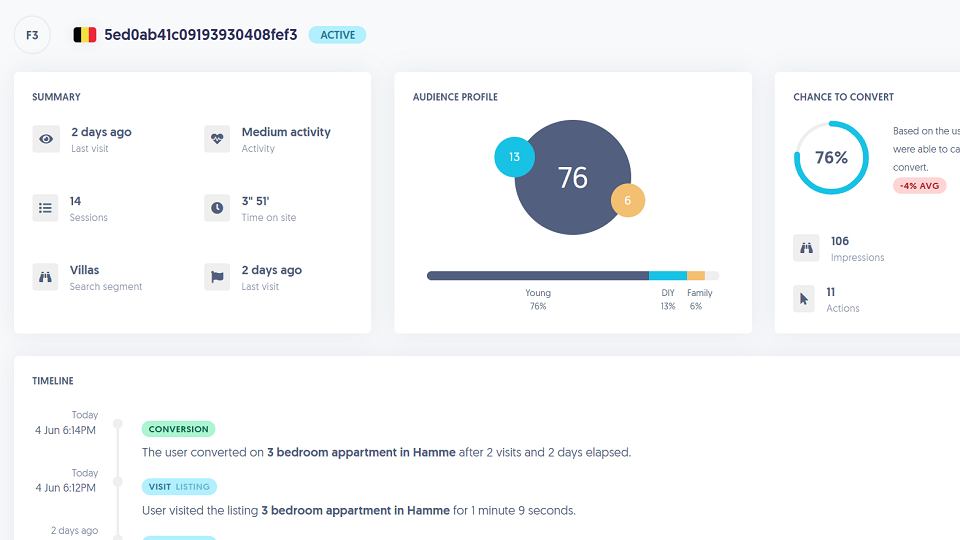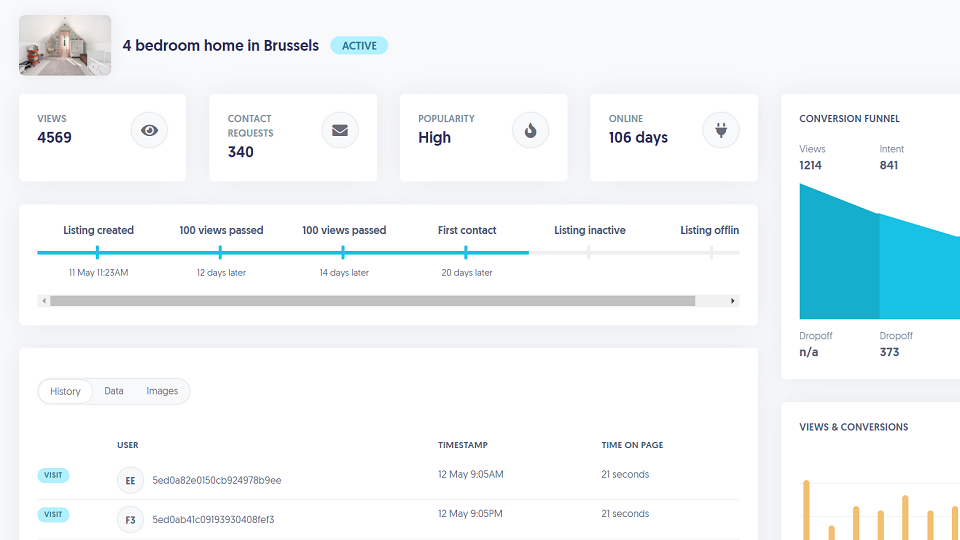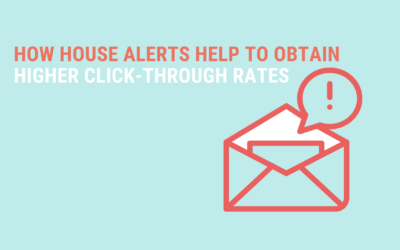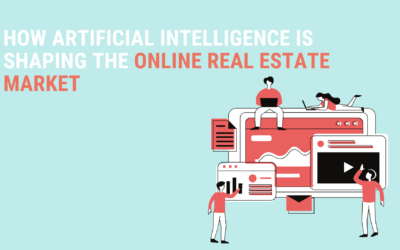How predictive analytics is transforming real estate today and in the future
7 August 2020 | 6 min read

You don’t have to look far to see examples of these technologies in action all around us. Machine learning is already being used in email spam filters, facial recognition technologies, and language translation services.
Predictive analytics is another area of AI that is surrounded by heaps of excitement for how it can shape our futures. A tool that predicts events that haven’t yet happened might sound like a futuristic tool from a science fiction movie, but it’s already here.
Today’s marketers are using it to deliver what their clients want before they even know it themselves.
Several predictive analytics tools are already helping businesses achieve huge successes. For example, furniture retailer, Room & Board, uses predictive analytics to reach their customers more intelligently and effectively. They implemented Salesforce’s Marketing Cloud technology to analyze customer traffic data, give predictive analytics, and suggest additional purchases to clients in real-time. The result: 2900% ROI.
Predictive analytics isn’t just for furniture retailers or any one industry. Predictive analytics has captured the attention of a wide range of organizations from every industry and this is why the global market is expected to reach $10.95 billion by 2022.
Predictive analytics can lead to amazing results in every industry and real estate is no exception. Let’s take a look at how predictive analytics is transforming the real estate industry today and in the future.

What is Predictive Analytics?
Before we can dive into exactly how predictive analytics is disrupting the real estate industry, first we need a quick recap about what predictive analytics is. Put simply, predictive analytics is a marketing strategy aimed at delivering unique experiences to each user.
Predictive analytics tools use a combination of historical data, behavioral analytics, and real-time data to build a profile of customer preferences. With enough good data, the algorithm can predict the customer’s future buying patterns. It can predict what the customer will want in the future.
When you have a high degree of confidence in your customer’s preferences, you can begin to deliver unique recommendations to customers. This offers a more personalized experience to customers, ensuring that they only see relevant content.
You may not have noticed it, but you’ve already experienced predictive analytics in your everyday life. When you get personalized recommendations on Netflix or YouTube, this is predictive analytics in action.
If you’ve ever checked the weather forecast for next week or placed a bet on the success of a sports team, then you’ve already used predictive analytics to inform your choices.
Too much to read right now? Download the blog here in PDF:
3 Ways Predictive Analytics is Transforming The Real Estate Industry Today
Predictive analytics is already causing significant disruption in the real estate industry, but why? It all comes down to data. While it’s true that we have been generating data for many decades now, it’s only recently that we have started to harness this data to create actionable insights.
Today, we are creating more data than we ever have in the past, and the amount of data we create is growing exponentially. In 2018 it was estimated that 2.5 quintillion (18 zeros!) bytes of data were created every day. A few years on from this, we can only imagine that the number is much higher today.
As we’ve moved away from traditional analytics methods and started to utilize emerging technologies and new and unconventional data sources, the power of predictive analytics has been unlocked.
This new way of working benefits both real estate professionals and consumers alike. With that in mind, here are the 3 major ways that predictive analytics is impacting the real estate industry today.
1. Predictive analytics help portals understand their customer’s journey
Most users’ customer’s journeys will start online. In the digital age, the internet is usually the starting point for every future homeowner. They typically don’t reach out to a real estate agent until later in their journey when they have a more concrete idea of what they’re looking for.
With the help of predictive analytics, agents can utilize user data to understand the buyer’s journey in a more comprehensive way. They can pinpoint consumers who are in the market to purchase a home and reach them with the right message, at the right time.
They could also segment their users into different types based on their behavior on the website. Some examples of those types could be first time buyers, investors in real estate, homeowners willing to sell or rent their property, DIY’er, and more.
Naturally, different segments of customers will have different preferences, motivations, and behaviors, and by capitalizing on these differences agents can offer a tailored experience to each type of customer.
Real estate portals could implement the same concept as Amazon’s predictive recommendations, offering endless property suggestions that will appeal to interested users.
Additionally, property matching has the potential to show buyers homes that match their lifestyle instead of their search criteria. This can introduce consumers to new types of homes and neighborhoods they may not have otherwise considered. One key benefit of Property matching is that it can reduce the number of days a house sits on the market and save buyers the time of sorting through hundreds of property listings that aren’t a good match for them.

2. Predictive analytics help investors with finding the right property (with GIS)
Investors frequently make educated decisions based on reliable data. Predictive analytics makes it significantly easier for investors to find the perfect investment property because predictive analytics is powered by huge amounts of clean and reliable data.
It should come as no surprise that location is an important factor for property investors looking for their next lucrative investment. With predictive analytics tools like heatmap analysis, investors are given useful and actionable information that can inform their choice.
Heatmap analysis works by predicting the best areas within a particular city for rental property investments, or other criteria. This helps investors pick the right properties and maximize profits.
Even if the investors aren’t familiar with a neighborhood, they can use heatmap analysis to find the best area based on metrics such as property value, rental income, and occupancy rate.
Predictive analytics can also show real estate investors find the indispensable features of the most valuable properties in a particular housing market. For example, predictive analytics may show that to get the most return on investment, a house with two bedrooms would be an optimal choice in a specific neighborhood.
An example of a task solvable using GIS is to load all property transactions within a given year, and also load extra data such as public transportation, parks, shops, schools, restaurants, and more, then automatically determine which properties are within a specified radius of those locations. You can then statistically test whether these properties have higher per square foot pricing than those further away.
This powerful technology is now used to forecast trends in the market as well. Investors always want to buy properties for cheap in up-and-coming neighborhoods. The challenge has been figuring out which neighborhoods are growing and which aren’t.
Big data can potentially make these recommendations based on historical data and current investment trends. With predictive analytics, real estate investing is no longer just for experts or those remarkably lucky at guesswork. Technology is now making investing accessible to those without a real estate background or deep financial knowledge.
“The most indispensable predictive analytics tools five years from now are those that help agents communicate on a deeper level with clients about property condition. – RISMedia-“

3. Predictive analytics make smarter valuation models
According to RISMedia’s 2017 Real Estate CEO Exchange, the most indispensable predictive analytics tools five years from now are those that help agents communicate on a deeper level with clients about property condition.
Home improvement ROI is a hot topic that potential sellers often want to discuss with agents. Naturally, sellers want to know how for example renovating their kitchen will impact the value of their home. Predictive analytics has the power to shed light on this area.
By analyzing the upgrades and improvements of local homes, predictive analytics can identify what kind of properties local buyers are willing to pay more for, or the condition they expect at a particular price.
Armed with this helpful information, agents can recommend specific home upgrades or renovations that allow sellers to earn more at closing. Agents can also give this information to sellers early on so they have the time and budget to make necessary improvements.

The Future of Predictive Analytics in Real Estate Marketing
Predictive Analytics Is Changing B2B Marketing
In the past, marketers would manually determine which stage of the customer journey the customer was currently in.
For example, manual leads would happen when a marketer assigns a certain value to leads based on their analysis. This process is often ineffective because it’s vulnerable to the changing whims of customers and doesn’t take into account their unique preferences as an individual.
Predictive intelligence uses a prospect’s behavior and past purchasing history to predict what they are looking for and when they will likely buy. This all happens through big data where the AI engines determine which leads are most likely to convert and sales reps can focus on leads that will provide the business most value.
This technology is making it possible for even small B2B companies to grow rapidly and actualize their potential faster than traditional methods.
Predictive Analytics in the Real Estate Landscape
A 2017 study by Imprev found that around 65% of top real estate executives are more likely to invest in predictive analytics, marketing automation, and Big Data by 2022.
Predictive analytics is transforming the future of the real estate landscape due to its powerful ability to provide quick and accurate actionable insights.
This has largely happened because of the advent of Big Data and the ways in which we can harness the hidden power within real estate data today. As we move to the future, we expect to see predictive analytics playing an even bigger role in transforming the real estate landscape.
We’ve already established in the last section that predictive analytics is improving the house hunting experience. As we move to the future, we expect to see real estate portals become even more advanced. We expect to see real estate companies designing their digital landscape to run on AI and predictive analytics to provide a more intelligent and personalized experience to customers.
Many real estate companies today are still using antiquated technology, clunky websites, and poor user interfaces. These companies are most vulnerable to the disrupting potential that predictive analytics is having in the industry.
There’s already a gap between the forward-thinking companies who are adopting emerging technologies, and those that aren’t. But as AI continues to advance, this gap will only widen, leaving companies left behind.
“Predictive analytics is analyzing extracted data, using old data to predict the future. The big difference now is we have new data points that we can apply to our industry. We’re moving from the idea of hindsight to insight to foresight.” – Dave Garland, REALTORS-
The Future of the Online Real Estate Sector
AI technologies such as predictive analytics are barely scratching the surface of the real estate sector. This technology will change the landscape of the real estate industry for buyers, sellers, and real estate companies themselves.
It’s important to understand how this technology works and it’s potential is crucial moving forward. Predictive analytics tools will become so common that they’re no longer only available to data scientists. They will become a ubiquitous part of our lives.
Emerging technologies like these are growing rapidly and becoming more and more accessible every day. As these technologies continue to advance, the speed of change continues to accelerate too.
If you’re ready to start your predictive analytics journey and provide better customer experiences, increase your conversions, and get ahead of your competitors, then we’re here to help. Reach out to us to get a free 30 min call with one of our experts and learn more about the possibilities of real estate technology. Contact us today.
Too much to read right now? Download the blog here in PDF:
Related articles
How House Alerts Help To Obtain Higher Click-Through Rates
Thanks to house alert systems, you can quickly inform potential buyers when new properties that match their criteria show up. Here is a step-by-step guide that will show you how you can retarget potential customers and help them find the house of their dreams.
Two Unique Dashboards That Will Help Your Real Estate Agents Close More Deals
Being successful in sales is about knowing your product inside out and knowing everything there is to know about your customer. Luckily, it’s easier to achieve these two goals today than ever before by using some unique dashboards. Read everything about it here:
How Artificial Intelligence is Shaping the Online Real Estate Market
Now in 2021, the message is clear; AI is here, and it’s here to stay. But what impact does this technology have on the real estate market? Read everything about it in this article



